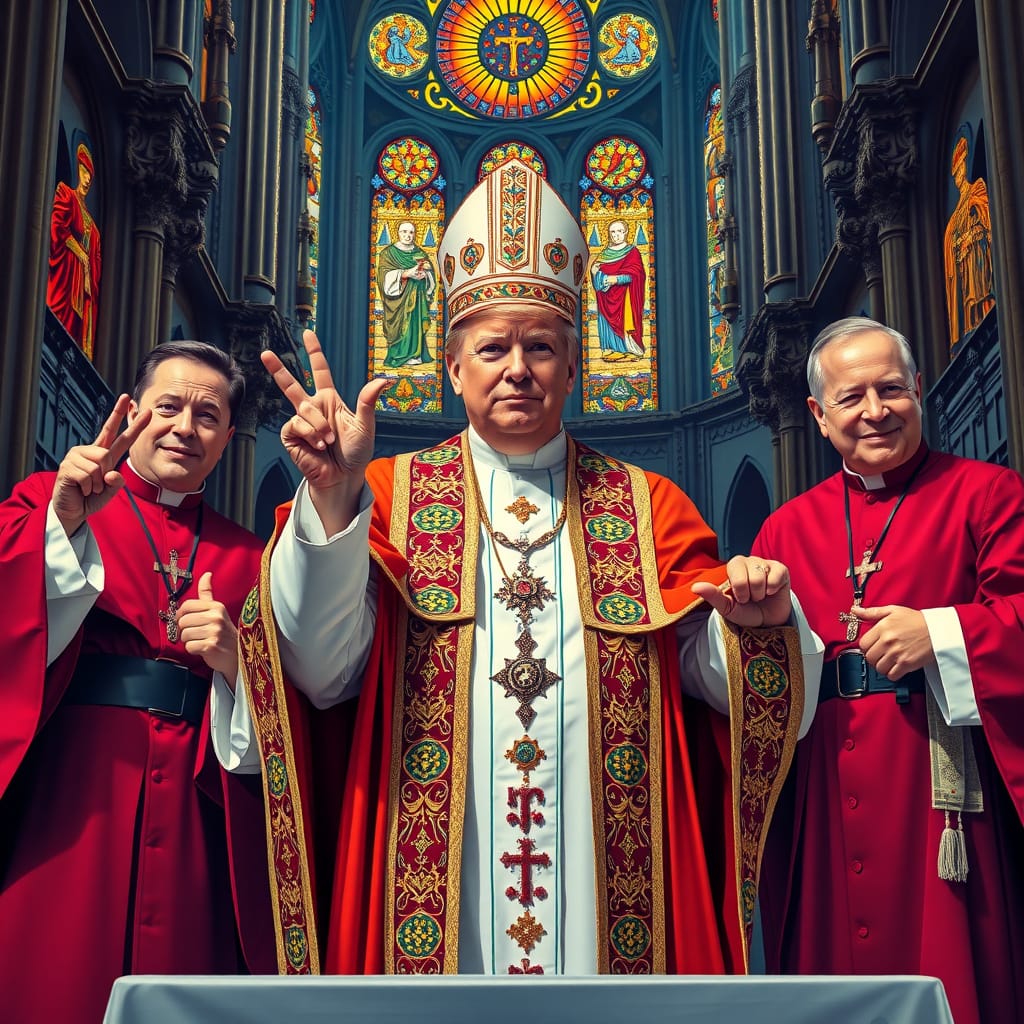Warning: This article may contain traces of truth. Consume at your own risk!
In what digital anthropologists are calling “the most predictable development since Instagram influencers discovered angles,” the US President Donald Trump has once again demonstrated his unparalleled mastery of the internet’s true operating system: attention economy OS. Last Friday, Donald Trump posted an AI-generated image of himself dressed in full papal regalia, just days after Pope Francis’s funeral and right before cardinals gather to elect a new pontiff. The resulting Catholic community outrage, viral spread, and media hand-wringing proved yet again that on today’s internet, the digital Colosseum that makes Rome’s Colosseum writhe in jealousy, the algorithm only rewards those willing to sacrifice dignity for engagement.
The Sacred Art of Digital Blasphemy
The image – showing a stern-faced Trump seated in an ornate chair, adorned in white papal robes and headdress, with his right index finger raised in benediction – managed to accomplish what political scientists call a “full-spectrum attention capture.” It offended religious sensibilities (the New York State Catholic Conference declared “there is nothing clever or funny about this image”), energized supporters (who defended it as “just a joke”), and forced political opponents to once again express their outrage about behavior that would have ended any previous US presidency within hours.
This papal provocation follows a now-familiar playbook of attention warfare that Donald Trump has deployed consistently since entering US politics. But more importantly, it illustrates the evolution of what we have identified as “The Attention Hunger Games”- a digital bloodsport where contestants like Donald Trump, Elon Musk, and Andrew Tate battle not for policy victories or genuine cultural influence, but for something far more valuable on the internet: eyeballs.
“When a post gets 100,000 likes but also generates 50,000 negative comments, that’s not a PR disaster – that’s an attention jackpot,” explains Dr. Eleanor Metrics, Head of Digital Anthropology at the Institute for Algorithm Studies. “The engagement algorithm doesn’t distinguish between love and hate. It only measures intensity and volume.”
The Economics of Outrage Manufacturing
What makes Trump’s papal performance particularly noteworthy is its perfect timing as a distraction mechanism. As tariffs drive consumer prices higher and international tensions escalate, the White House has learned that a well-timed algorithmic firebomb can reset the national conversation faster than you can say “did you see what he posted now?”
The White House’s decision to amplify the image through its official accounts-moving it from Donald Trump’s personal Truth Social feed to government platforms with wider reach – demonstrates how thoroughly the administration has institutionalized attention manipulation as official policy. Press Secretary Karoline Leavitt defended Trump as “pro-Catholic,” a statement that managed to both miss the point and extend the controversy’s half-life by at least 48 hours.
But this is merely the visible surface of a far more sophisticated attention warfare strategy that connects seemingly disparate figures in what can only be described as the Avengers of Digital Distraction.
The Unholy Trinity of Attention Oligarchs
If Donald Trump is the undisputed heavyweight champion of attention combat, Elon Musk and Andrew Tate represent the evolution of his techniques into something potentially more dangerous: a networked attention cartel that amplifies each other’s provocations through a sophisticated feedback loop.
Elon Musk, now officially the head of Trump’s Department of Government Efficiency (DOGE) – an acronym choice that itself was an attention hack – has long practiced what attention economists call “manufactured controversy farming.” His deliberate posting of provocative content ensures his personal brand remains central to public discourse, regardless of how his companies actually perform.
The Andrew Tate connection reveals an even darker dimension. Despite facing serious charges including human trafficking and rape in Romania, Andrew Tate’s return to the United States was celebrated with UFC CEO and Donald Trump ally Dana White greeting the Tate brothers with “Welcome to the United States, boys” in Las Vegas. This public embrace of Tate – the self-described “king of toxic masculinity” – wasn’t a PR blunder; it was an attention market cornering operation.
“The attention economy rewards people who are narcissistic and self-promotional because these people excel at getting attention,” notes Mark Manson, attention economy analyst. “Therefore, it seems that everyone is becoming more shallow and self-absorbed, when in fact, we are merely becoming more exposed to other people’s self-promotion.”
This alliance between Trump, Musk, and Tate represents what game theorists call a “monopolistic attention cartel” – a coordinated effort to control as much of the finite attention supply as possible through mutually reinforcing provocations.
The Quantifiable Returns on Blasphemy Investment
While mainstream analysis frames the Pope Trump image as a gaffe, the metrics tell a different story. Within hours of posting, the image had accumulated over 100,000 likes on Instagram alone. By generating thousands of news stories, trending topics, and forcing even Catholic Cardinal Timothy Dolan of New York to respond (“it wasn’t good”), the AI-generated stunt achieved what attention economists call “total saturation” – the point at which a single piece of content infiltrates every level of media discourse simultaneously.
This isn’t just political theater – it’s quantifiable attention ROI. For the cost of generating a single AI image, Trump captured the equivalent of millions in earned media, diverted attention from policy issues, and reinforced his brand as the central character in America’s ongoing political drama.
“In the attention economy, there’s no separation between winning and losing the conversation – only between dominating it and being excluded from it,” explains Dr. Wei Metrics from the Department of Digital Anthropology. “Trump’s papal provocation is the digital equivalent of a tactical nuclear strike in the battle for mental real estate.”
The Weaponization of AI-Generated Controversy
What makes this particular episode technologically significant is the deliberate use of AI to manufacture the controversy. By using AI image generation rather than conventional photo manipulation i.e photoshop, Trump simultaneously creates plausible deniability (“it’s just AI playing around”) while showcasing his embrace of cutting-edge technology.
This isn’t the first time Trump has deployed AI imagery as an attention weapon. He previously faced criticism for posting AI-generated footage imagining war-ravaged Gaza as a Gulf state-like resort featuring a golden statue of himself. These aren’t random provocations – they’re calculated deployments of what attention strategists call “cognitive override assets.”
Dr. Algorithms, lead researcher at the Attention Warfare Institute, explains: “The human brain processes images 60,000 times faster than text. An AI-generated image that combines familiar elements in jarring new contexts creates a cognitive dissonance that the brain can’t easily resolve. This dissonance demands attention and processing power, essentially hijacking mental bandwidth.”
The Ideological Portal to Post-Truth
The deeper significance of this attention warfare extends beyond political theater. According to recent research, the attention economy serves as “a portal to the post-truth era” by eroding shared reality itself.
“Within the Attention Economy, supply and demand dynamics eat into the big tent version of the public, carving out multiple contending publics adhering to a shared conviction in their data, facts, and images as accurate, virtuous, and informed while disparaging and viewing those adhering to others as misinformed,” notes one academic study.
This explains why Trump’s supporters and critics can look at the same AI-generated papal image and see completely different things: one group perceives harmless humor, the other blasphemous disrespect. They’re not merely disagreeing about interpretation – they’re experiencing fundamentally different realities constructed by their respective attention ecosystems.
The papal provocation thus serves as a perfect case study in what theorists call “collision ideology” – the deliberate cultivation of incompatible realities that prevent meaningful dialogue across political divides.
The Masculinity Monetization Machine
Perhaps the most overlooked aspect of this attention cartel is its deliberate appeal to what NYT columnist Tressie McMillan Cottom identifies as a “crisis of masculinity.” Trump’s cultivation of relationships with figures like Tate, Musk, and UFC personalities creates a network that economist Jordan Peterson calls “the aspirational masculinity industrial complex.”
“Trump and Elon are particularly adept at exploiting this situation because they have emerged from it,” observes McMillan Cottom. “Elon Musk is a product of the internet economy; he comprehends how emotions and outrage drive algorithms, which in turn generates profit through attention.”
This explains why Trump’s seemingly random associations with figures like Andrew Tate form a coherent strategy. The “manosphere” delivered crucial support to Trump’s election victory, with the president improving his share among young men. This demographic isn’t responding to policy positions-they’re responding to the performance of a specific type of aggressive, consequence-free masculinity that the attention economy rewards and amplifies.
The Algorithm-Human Feedback Loop
The most disturbing implication is that this attention warfare isn’t just changing politics around the world – it’s rewiring our brains. Neurologists have documented how social media algorithms create what’s called “intermittent variable rewards” – the same mechanism that makes gambling addictive.
“When you never know if the next scroll will bring outrage, validation, or a new controversy, you’re essentially pulling a slot machine lever in your mind,” explains Dr. Neural Networks, lead researcher at the Digital Cognition Institute. “Trump, Musk, and Tate have intuitively mastered the art of being the jackpot prize in this cognitive casino.”
This explains why traditional media struggling with “both sides” coverage can’t effectively counter attention warfare. Traditional journalism assumes information consumption is rational, while attention warriors understand it’s primarily emotional and algorithm-driven.
The Digital Colosseum’s Future
As the papal provocation fades from the headlines, replaced inevitably by the next manufactured controversy, the long-term implications become clear: we’re witnessing the full maturation of attention warfare as America’s dominant political technology.
Traditional political analysts still frame these episodes as gaffes or miscalculations, missing that they represent a deliberate strategy optimized for the attention economy’s metrics. There are no “distractions” from the real issues-the distractions are the strategy.
For citizens hoping to maintain some cognitive sovereignty in this environment, the outlook isn’t encouraging. Every act of outrage, every shocked share, every quote-tweet with “Can you believe this?” feeds the very system it purports to resist. The attention economy has no moral compass – it only has engagement metrics.
As cardinals gather to select the next pope, Trump’s digital blasphemy will have achieved its purpose: another cycle of attention captured, another news cycle dominated, another incremental erosion of what was once considered presidential behavior. Meanwhile, a distracted public continues responding exactly as the attention algorithm predicts.
The real question isn’t whether Trump’s papal provocation was appropriate-it’s whether we’ve built a digital ecosystem that makes such provocations inevitable, rewarding them regardless of their social consequences. In the attention economy’s ruthless logic, there is no difference between fame and infamy, only between being seen and being ignored. And in that economy, Trump’s papal portrayal wasn’t a mistake-it was a masterclass.
Have you noticed other examples of attention warfare in your digital life? Do you catch yourself giving attention to provocative content even when you know it’s manipulating you? Is there any escape from the digital Colosseum, or are we all just gladiators in the attention arena now? Share your thoughts in the comments below!
Support Journalism That Doesn’t Mine Your Outrage For Profit
If you've enjoyed this analysis of how our digital overlords manipulate your precious attention, consider supporting TechOnion with a donation. Unlike the attention merchants we've exposed today, we won't use sophisticated algorithmic techniques to extract maximum engagement from your cognitive vulnerabilities. Instead, we'll use your contribution to continue producing content that helps you understand how thoroughly you're being played by people who view your attention as their property. Think of it as paying for the red pill rather than being forced to swallow the blue one for free!






GIPHY App Key not set. Please check settings